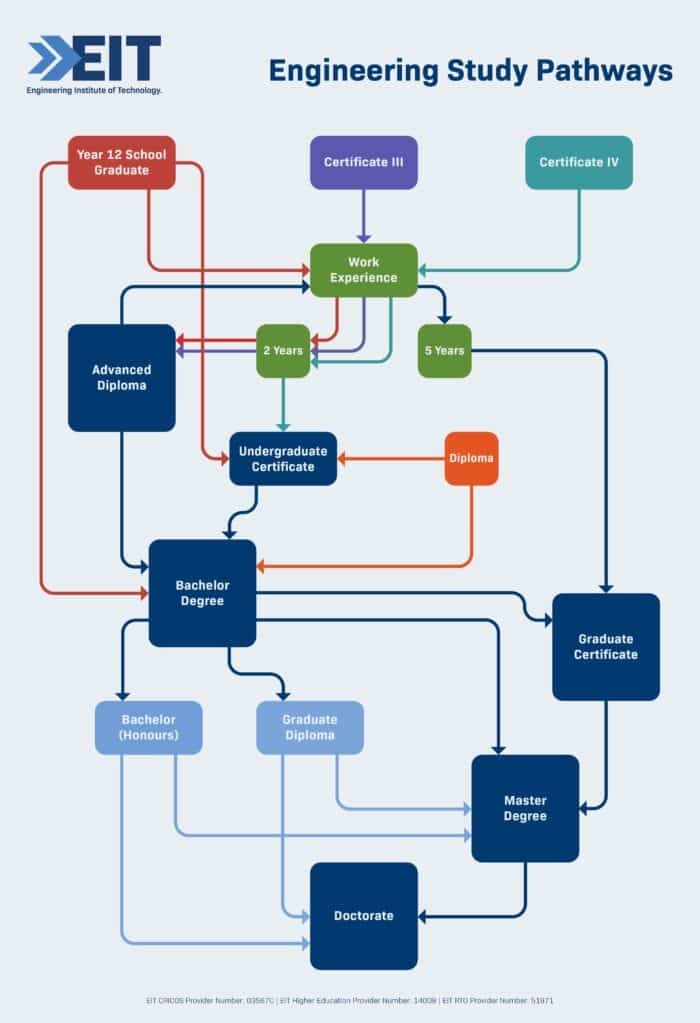Engineering is always evolving and so is education.
It means that there’s a lot of ways engineers can keep current, upskill, change the direction of their career or even add more qualifications to their name.
If your goals for 2022 include any sort of professional development or upskilling, having solid knowledge of pathways within the engineering field can be a good guide to help you take the next step.
There are multiple ways to get you from point A to B, and that’s a great thing for any EIT student, because a pathway to a dream career is always available, no matter where you start.
The Meaning of Educational Pathways
Within engineering, it is believed that individual, personalized educational pathways are used in higher education to optimize the educational process and meet the needs of students to be able to enter the job market.
According to a 2021 article Development of a Model for Individual Educational Pathways in Engineering Education a major area of pathways is individualization, meaning there should be more tailored options for students.
This means that not only can students decide on different courses, they can also experiment with what they enjoy doing.
As a result, following graduation and some time as an employee, a graduate might be tempted to do a bridging course to study in a different field of engineering.

The EIT Way
- If you just graduated from school, and do not have work experience, the best pathway is starting with an Undergraduate Certificate and then getting into a Bachelor’s Degree (with full credit from Undergraduate Certificate).
- From this point, you can choose to work in the industry at an engineering technologist level, or you may want to add another year for Bachelor (Honours) or progress with a Master’s Degree to become a professional engineer.
- For school graduates with relevant work experience, this is also true but additional opportunities become available. For those with 2+ years of experience, Advanced Diplomas may be a great choice.
- For applicants with trade qualifications (Certificate III or Certificate IV by Australian Qualification Framework) with 2 years’ work experience can also apply for Advanced Diplomas, and after 5 years’ experience EIT’s Graduate Certificate can become the next step.
- Candidates with Bachelor (Honours) level can choose the Graduate Certificate or Master’s Degree or even a Doctor of Engineering as the next step in their engineering career.
- Graduate Diploma qualification can also build a bridge between vocational and higher education and work as a stepping stone to the highest level of engineering qualification – Doctor of Engineering.
Professional Development and Exploring New Areas
For anyone wanting to add new skills, our Professional Certificate of Competency courses has become a valuable way to certify new knowledge.
At EIT we offer 35 Professional Certificates that are 3 months in duration.

The certificates vary from introducing Artificial Intelligence to Civil engineering basics, meaning that they add a lot of value to those applying for the course because they have a choice in what area they would like to expand their knowledge.
At EIT these courses are usually aimed at technicians, technologists, or engineers that are already working and entrants are expected to spend up to 8 hours per week learning the course content.
This includes attending webinars. It is all designed to fit around full-time work.
These certificates are industry-specific and focused on students with an engineering, mathematics or scientific background.
Different Requirements to Study
The main difference about “where to start” largely depends on entry requirements for a particular course.
When comparing Advanced Diplomas and Bachelor of Science Degrees at EIT it’s worth noting what the requirements are to enter these qualifications.
Advanced Diplomas
EIT currently offers 13 Advanced Diplomas. Most take 18 months to complete, others 24 and then 48 months to complete.

The advanced diplomas are accelerated, practical, work-oriented programs designed for engineers and technicians who have a background in the field.
This includes those who have technical or ‘trade’ qualifications who want to move to the next career step, those with substantial relevant work experience who need to formalize and enhance their achievements, and those with higher-level qualifications in a related field who wish to develop specialist knowledge.
As a result, the entry does require some previous qualification and work experience also count in the favor of applicants.
It’s worthwhile to ask relevant questions online and check if you meet the entry requirement.
Programs Accredited and Currently offered at the level of Engineering Associate (Dublin Accord):
1) Advanced Diploma of Industrial Automation (52708WA) Formerly (52403WA) – Full Status
2) Advanced Diploma of Applied Electrical Engineering (52726WA) Formerly (52465WA) – Full Status
3) Advanced Diploma of Mechanical Engineering Technology – (52810WA) – Provisional Status
Bachelor Degrees
EIT offers three-year Bachelor of Science Degrees in many engineering disciplines.

These degrees are good options for school leavers who meet the entry requirement and have no previous work experience. However, some credits from Diploma and Advanced Diploma courses, as well as Undergraduate Certificates, can be transferred for credit within the Bachelor of Science courses.
Currently, four programs have been accredited and offered at the level of Engineering Technologist (Sydney Accord).
Programs accredited and offered at the level of Engineering Technologist (Sydney Accord):
1) Bachelor of Science (Electrical Engineering) 2017 – Full Status
2) Bachelor of Science (Mechanical Engineering) 2016- Full Status
3) Bachelor of Science (Civil and Structural Engineering) 2017 – Provisional Status
4) Bachelor of Science (Industrial Automation Engineering) 2016 – Full Status
Master of Engineering
To gain esteem as a Professional Engineer under the Washington Accord EIT offers two accredited and courses at this level.
To enter these qualifications a formal degree is required, but work experience, as well as graduate certificates, is also credited as valuable.
Programs accredited and offered at the level of Professional Engineer (Sydney Accord):
1) Master of Engineering (Electrical Systems) – Full Status
2) Master of Engineering (Industrial Automation) – Full Status
On Becoming an Engineer
Perhaps it’s useful to know what qualifications are needed to work as an engineer at different levels.
A great online guide by author Louis E. Frenzel Jr. splits the roles between Technician, Technologist and Engineer – and what is required to perform in that capacity.
What is a Technician?
In most cases, technicians have completed a two-year qualification like a Diploma or Advanced Diploma. Technicians with an associate degree can usually transfer to a Bachelor of Technology (B.Tech) and complete the bachelor’s degree in another two to three years. Their pathway from an initial two-year qualification could also lead to entry into a Bachelor of Engineering or Bachelor of Science degree –providing they can transfer their credits.
According to Frenzel, technicians are most often employed in service jobs like installation, repair testing or maintenance.
There’re many identifiers for these professionals that include field service technicians, customer representatives, engineering technicians, engineering assistants or associate engineers. These engineers usually completed a Dublin accord qualification.
What is an Engineering Technologist?
Engineering Technologists are specialists that are devoted to the implementation of existing technology that works with engineers. Engineering Technologists often know and apply basic engineering principles and have a good technical skillset.
The Sydney Accord agreement means that only some countries offer qualifications in line with professional development where someone can work as an Engineering Technologist.
Graduates would have a diploma from an accredited curriculum, will have a set amount of work experience in their field and are then registered technologists. Engineering technology education focuses on the applied aspects of science and engineering and is aimed at preparing
graduates for practice in the portion closest to product improvement, manufacturing, construction, and engineering operational functions.
Technologists have a variety of skills and specialities and are, according to Frenzel, likely to be employed in an array of industries. But, technologists are also able to move into managerial roles within their prospective fields. Usually, Engineering Technologists start in product design, testing, system development or quality control – before working their way up the career ladder.
There’s also a growing number of advanced courses Engineering Technologists can complete as they grow in the field and use their practical skills.
What is an Engineer?
The major difference between graduate engineers and technicians and technologists is their educational background.
The Accreditation Board for Engineering and Technology gives a specific guide to understanding the differences between Technologists and Engineers – but also their core relationship.
Engineering undergraduate degrees will include more math and a higher level of mathematical skills than technology-driven courses. Majorly engineering degrees often focus on theory while technology programs focus on the application of theory. In the work, environment engineers will usually be the face of planning, while engineering technologists make those plans work.
Engineers most often hold a Bachelor of Engineering or Bachelor of Science degree within a field of engineering. Another major differentiator is the fact that engineers with a Bachelor’s degree can enter postgraduate degrees like a Master of Engineering or a Doctor of Engineering degree which will strengthen their theoretical aptitude.
Engineering Accords explained
Different engineering qualifications also hold different accords, which means you can have a good idea of what kind of engineer you will become according to the accreditation of your qualification.
The various international accords have been signed by most countries for accrediting tertiary-level education and show where those qualifications are recognized. According to the International Engineering Alliance the Washington Accord, Sydney Accord and Dublin Accord are three multi-lateral agreements between groups of jurisdictional agencies responsible for accreditation or recognition of engineering qualifications. The aim is to have a globalized knowledge of what esteem qualifications hold.
Washington Accord
This gives recognition of equivalence of educational base for engineers at a professional level.
Three or four year Bachelor Degrees qualify as part of the accord and according to The education of mechanical engineers – an international comparison of programs recognized by the Washington Accord engineers must at least be able to demonstrate the ability to apply their knowledge of science and engineering fundamentals, the ability to communicate effectively with other engineers and their community, technical competence in at least one engineering discipline, good problem identification, formulation and solutions among a list of checks.
Sydney Accord
This gives recognition of equivalence of educational base for Engineering Technologists.
The Sydney Accord was signed in 2001 by Australia, Canada, Hong Kong, South Africa, New Zealand, and the United Kingdom to recognize engineering programs accredited at the Incorporated Engineer level.
Dublin Accord
This gives recognition of equivalence of educational base for Engineering Technicians.
The accord was signed in 2002 by national engineering organizations of Canada, Ireland, South Africa, and the United Kingdom. It mutually recognizes the qualifications that underpin the granting of Engineering Technician titles in four countries.
Why Accords Matter
It helps engineers be more global. A new article published January 2022 titled Moving Towards International Engineering Program Recognition and Accreditation for Latin America and the Caribbean lauds the fact that the increase in multi-national engineering projects means it has become critical that engineers be graduates of internationally recognized programs.
Many countries have established national accrediting agencies for engineering programs, and that is why the three accords remain important.
There’s mutual recognition among all the countries that have signed individual accords or all three that qualified engineers completed accredited programs.
References:
Naumkin, Nikolay & Ageev, Vadim & Sadieva, Anarkul & Anokhin, Anatoly & Shekshaeva, Natalya & Zabrodina, Evgeniya. (2021). Development of a Model for Individual Educational Pathways in Engineering Education. Economic History. 25. 513-531. 10.15507/1991-9468.104.025.202103.513-531.
Page, Neil. (2006). The education of mechanical engineers – an international comparison of programs recognised by the Washington Accord. 10.13140/RG.2.1.1055.0006.
Chandrasekaran, Siva & Littlefair, Guy & Allison, Janelle & Symes, Mark. (2017). A Collaborative Mapping Approach – Framing an Engineering Pathway.
Karam-Zanders, T. & Jones, S.C. & Jr, Waggenspack, & Acklin, Dina. (2015). BRCC to LSU engineering pathway to success – Assessment measures. ASEE Annual Conference and Exposition, Conference Proceedings. 122.


